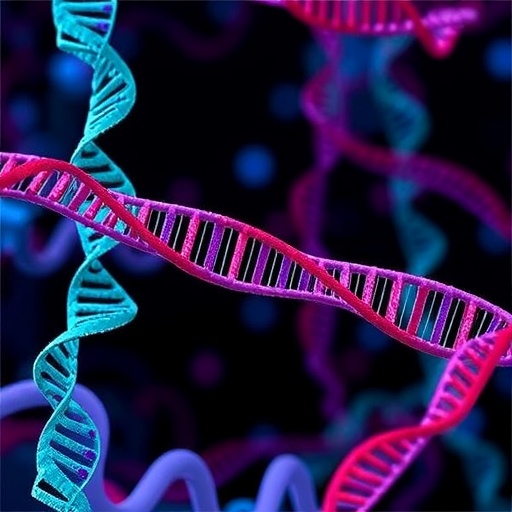In the intricate environment of the cell nucleus, nuclear speckles have long been recognized as critical hubs for RNA processing and gene regulation. Recent groundbreaking research has illuminated a novel, feedback mechanism by which these dynamic structures regulate the localization and translation of a particular subset of mRNAs enriched in GA repeats. This new understanding reveals that nuclear speckles do more than just organize splicing factors—they actively modulate the fate of certain mRNA populations through their interaction with phase-separating protein domains known as arginine-rich mixed-charge domains (R-MCDs).
At the heart of this system is the C-terminal low-complexity domain (LCD) of the protein peptidylprolyl isomerase G (PPIG), which possesses an R-MCD. When fused to a fluorescent reporter and expressed in HeLa cells, this LCD accumulates inside the nucleus, co-localizing strikingly with SC35, a canonical marker of nuclear speckles. Intriguingly, the accumulation alters speckle morphology, producing fewer but larger speckles, which is consistent with previous reports of R-MCD proteins influencing speckle dynamics. This experimental setup offers a powerful model to dissect how changes in R-MCD concentration impact intracellular RNA distribution and subsequent protein synthesis.
Researchers carefully tracked the fate of endogenous mRNAs after induced expression of the PPIG LCD, leveraging advanced fractionation techniques coupled with 3′ end sequencing. This revealed a distinct dose-dependent nuclear retention of transcripts with high degrees of GA multivalency—meaning, those mRNAs enriched in GA repeats within their coding sequences. In contrast, mRNAs with fewer or no GA-rich elements remained largely unaffected. The gradation of nuclear retention directly correlated with the level of PPIG LCD expression, suggesting a fine-tuned selective gating mechanism operates within the nuclear speckles.
Such nuclear sequestration is not a trivial localization event—it has tangible effects on the cellular protein output. Using pulsed stable isotope labeling with amino acids in cell culture (pSILAC), the team quantified nascent protein synthesis during PPIG LCD induction. The results unveiled a compelling suppression of translation for proteins encoded by retained GA-rich mRNAs, while the translation of other proteins remained unchanged. This finding links nuclear speckle sequestration of mRNAs directly to a regulatory checkpoint governing protein production, adding a new layer to post-transcriptional gene regulation.
To validate that these effects arise from bona fide localization within nuclear speckles, the team employed hybridization chain reaction fluorescence in situ hybridization (HCR-FISH), a highly sensitive technique that can visualize specific RNAs at the single-molecule level. By targeting representative GA-rich and control non-GA-rich mRNAs, they observed a dose-dependent enrichment of the GA-rich transcripts within SC35-marked speckles upon PPIG LCD expression. This selective enrichment was absent in the non-GA-rich RNA controls, reinforcing the specificity of the speckle-mediated retention.
Importantly, this phenomenon was not limited to PPIG. Expression of R-MCDs derived from other proteins such as LUC7L3, PRPF38B, and SRSF11 recapitulated the speckle retention of GA-rich mRNAs, whereas low-complexity domains lacking the arginine-rich signature failed to do so. This highlights a conserved functional property of R-MCDs in governing the nuclear compartmentalization of GA-rich transcripts. It also suggests that variations in the combined intracellular concentrations of these condensation-prone domains could dynamically modulate mRNA fate within cells.
Remarkably, these regulatory effects emerge from relatively modest protein concentration changes. The study’s quantitative analyses revealed that a mere 15% elevation in total cellular R-MCD abundance sufficed to induce significant nuclear retention of GA-rich mRNAs. This sensitivity implies that cellular homeostasis for these modules is tightly controlled, potentially allowing cells to rapidly adjust gene expression outputs in response to physiological cues or stress conditions by modulating R-MCD concentrations or activity.
The biological import of these findings is profound. mRNAs containing GA-rich GeRM regions often code for proteins involved in RNA binding, splicing, or other condensation-prone activities. By sequestering these transcripts in nuclear speckles via R-MCD concentration thresholds, cells can exert collective homeostasis over protein products prone to phase separation and aggregation. This mechanism could serve as a fail-safe to prevent aberrant protein accumulation and maintain nuclear organization integrity.
Furthermore, the study provides valuable insights into the emerging paradigm of RNA and protein phase separation within the nucleus. It underscores that not only do proteins with specific low-complexity domains drive condensate formation, but also that the transcripts they encode are reciprocally regulated within these condensates. This reciprocity establishes nuclear speckles as regulatory nodes that interlink RNA sequence composition, protein domain properties, and cellular compartmentalization.
The selective sequestration strategy elucidated here may also have implications for neurodegenerative and other protein aggregation diseases. Aberrations in R-MCD concentration or function could dysregulate the delicate balance of mRNA distribution and translation, potentially leading to toxic protein accumulation or impaired gene expression. Thus, understanding the molecular determinants of speckle-mediated mRNA retention could reveal novel therapeutic targets.
From a methodological perspective, the authors’ multifaceted approach—combining inducible expression systems, high-throughput sequencing, proteomics, and super-resolution imaging—exemplifies a holistic strategy to unravel complex nuclear processes. The detailed structural predictions of the PPIG LCD via AlphaFold provided mechanistic clues about how amino acid composition underpins condensation propensity and specificity for GA-rich mRNAs.
In summary, this study reveals a sophisticated homeostatic network within the nucleus wherein R-MCD-containing proteins govern the spatial localization and translational output of GA-rich mRNAs. By mediating dose-dependent sequestration within nuclear speckles, cells can coordinate the expression of proteins that are themselves prone to forming biomolecular condensates. This feedback loop adds a new dimension to nuclear speckle function and emphasizes the interplay between RNA sequence features and protein domain architecture in cellular regulation.
As research continues to decipher the intricate code of RNA-protein interactions modulating nuclear organization, these findings pave the way for new explorations into how cells manage condensation-prone proteins via their own mRNAs. Harnessing this knowledge could yield novel strategies for modulating gene expression and preventing pathological protein aggregation in human diseases.
Subject of Research: Collective homeostasis of condensation-prone proteins via their mRNAs
Article Title: Collective homeostasis of condensation-prone proteins via their mRNAs
Article References:
Faraway, R., Costello Heaven, N., Digby, H. et al. Collective homeostasis of condensation-prone proteins via their mRNAs. Nature (2025). https://doi.org/10.1038/s41586-025-09568-w
Tags: arginine-rich mixed-charge domainsfeedback mechanisms in gene regulationHeLa cell model for RNA studiesintracellular RNA distribution analysislow-complexity protein domains in cellsmRNA localization and translation regulationnuclear speckles and RNA processingpeptidylprolyl isomerase G functionphase-separating protein domainsprotein synthesis modulationRNA-protein interaction mechanismsspeckle morphology and dynamics





